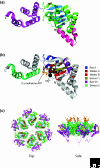The AAA+ superfamily of functionally diverse proteins
- PMID: 18466635
- PMCID: PMC2643927
- DOI: 10.1186/gb-2008-9-4-216
The AAA+ superfamily of functionally diverse proteins
Abstract
The AAA+ superfamily is a large and functionally diverse superfamily of NTPases that are characterized by a conserved nucleotide-binding and catalytic module, the AAA+ module. Members are involved in an astonishing range of different cellular processes, attaining this functional diversity through additions of structural motifs and modifications to the core AAA+ module.
Figures


Similar articles
-
A systematic classification of Plasmodium falciparum P-loop NTPases: structural and functional correlation.Malar J. 2009 Apr 18;8:69. doi: 10.1186/1475-2875-8-69. Malar J. 2009. PMID: 19374766 Free PMC article.
-
STAND, a class of P-loop NTPases including animal and plant regulators of programmed cell death: multiple, complex domain architectures, unusual phyletic patterns, and evolution by horizontal gene transfer.J Mol Biol. 2004 Oct 8;343(1):1-28. doi: 10.1016/j.jmb.2004.08.023. J Mol Biol. 2004. PMID: 15381417 Review.
-
Crystal Structure and Biochemical Characterization of a Mycobacterium smegmatis AAA-Type Nucleoside Triphosphatase Phosphohydrolase (Msm0858).J Bacteriol. 2016 Apr 28;198(10):1521-33. doi: 10.1128/JB.00905-15. Print 2016 May 15. J Bacteriol. 2016. PMID: 26953339 Free PMC article.
-
Dual-wield NTPases: A novel protein family mined from AlphaFold DB.Protein Sci. 2024 Apr;33(4):e4934. doi: 10.1002/pro.4934. Protein Sci. 2024. PMID: 38501460 Free PMC article.
-
Broad yet high substrate specificity: the challenge of AAA+ proteins.J Struct Biol. 2004 Apr-May;146(1-2):90-8. doi: 10.1016/j.jsb.2003.10.009. J Struct Biol. 2004. PMID: 15037240 Review.
Cited by
-
A pathogenic mutation in the ALS/FTD gene VCP induces mitochondrial hypermetabolism by modulating the permeability transition pore.Acta Neuropathol Commun. 2024 Oct 10;12(1):161. doi: 10.1186/s40478-024-01866-0. Acta Neuropathol Commun. 2024. PMID: 39390590 Free PMC article.
-
Phylogenetic classification of natural product biosynthetic gene clusters based on regulatory mechanisms.Front Microbiol. 2023 Nov 8;14:1290473. doi: 10.3389/fmicb.2023.1290473. eCollection 2023. Front Microbiol. 2023. PMID: 38029100 Free PMC article.
-
Modular and coordinated activity of AAA+ active sites in the double-ring ClpA unfoldase of the ClpAP protease.Proc Natl Acad Sci U S A. 2020 Oct 13;117(41):25455-25463. doi: 10.1073/pnas.2014407117. Epub 2020 Oct 5. Proc Natl Acad Sci U S A. 2020. PMID: 33020301 Free PMC article.
-
Suppressing male spermatogenesis-associated protein 5-like gene expression reduces vitellogenin gene expression and fecundity in Nilaparvata lugens Stål.Sci Rep. 2016 Jun 16;6:28111. doi: 10.1038/srep28111. Sci Rep. 2016. PMID: 27305948 Free PMC article.
-
Crystal structure of the ATPase domain of the human AAA+ protein paraplegin/SPG7.PLoS One. 2009 Oct 20;4(10):e6975. doi: 10.1371/journal.pone.0006975. PLoS One. 2009. PMID: 19841671 Free PMC article.
References
-
- Neuwald AF, Aravind L, Spouge JL, Koonin EV. A class of chaperone-like ATPases associated with the assembly, operation, and disassembly of protein complexes. Genome Res. 1999;9:27–43. - PubMed
Publication types
MeSH terms
Substances
LinkOut - more resources
Full Text Sources
Other Literature Sources

